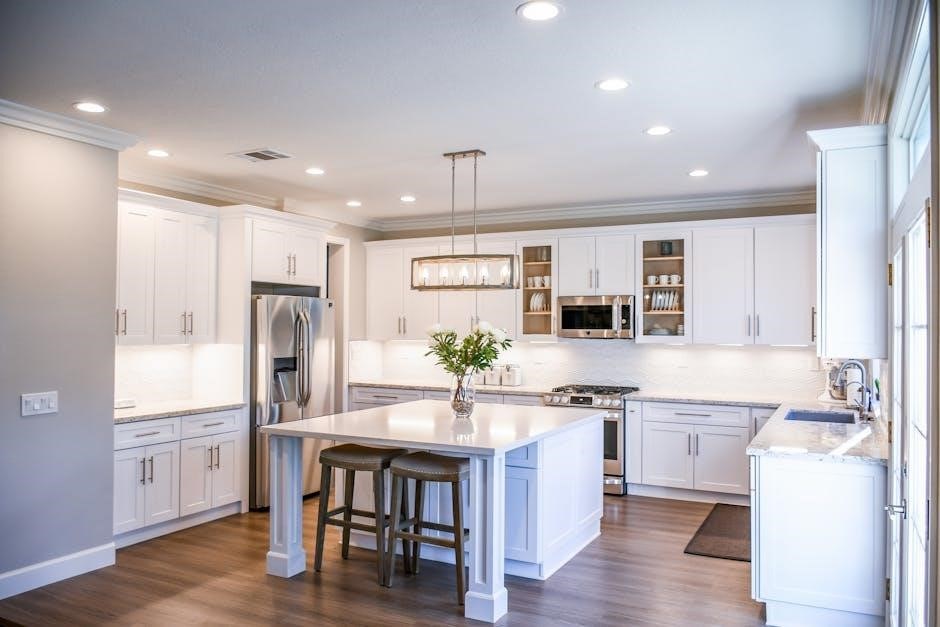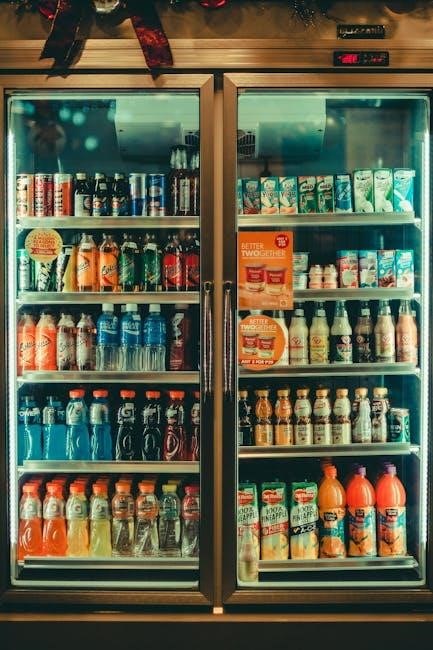This guide provides essential steps to diagnose and resolve common issues with Norcold refrigerators‚ ensuring safe and efficient operation in RVs and other applications.
1.1 Importance of Regular Maintenance
Regular maintenance is crucial for ensuring the optimal performance and longevity of your Norcold refrigerator. By addressing potential issues early‚ you can prevent major breakdowns and costly repairs. Proper upkeep also enhances safety‚ especially when dealing with propane-powered systems. Simple tasks like cleaning the burner‚ checking for gas leaks‚ and ensuring proper ventilation can significantly extend the life of your appliance. Additionally‚ routine checks help maintain consistent cooling performance‚ which is vital for preserving food quality. A well-maintained refrigerator operates more efficiently‚ reducing energy consumption and minimizing the risk of unexpected failures. Regular maintenance is essential for reliability and safety in RVs and other mobile applications.
1.2 Purpose of the Troubleshooting Guide
This guide is designed to empower users with the knowledge and tools to identify and resolve common issues with Norcold refrigerators. By providing step-by-step instructions‚ it helps diagnose problems such as cooling inefficiencies‚ unusual noises‚ and gas burner malfunctions. The guide also outlines essential safety precautions‚ ensuring users can address issues responsibly. Additionally‚ it covers diagnostic procedures‚ error code interpretations‚ and maintenance tips to prevent future problems. Whether you’re a seasoned RV owner or a newcomer‚ this guide offers clarity and confidence in troubleshooting. Its comprehensive approach balances DIY solutions with recommendations for professional assistance when needed‚ ensuring your Norcold refrigerator operates safely and efficiently for years to come.

Safety Precautions
Ensuring safety is crucial when troubleshooting your Norcold refrigerator. Always check for current leakage‚ unplug the unit before servicing‚ and ensure proper ventilation to avoid hazards.
2.1 Checking for Current Leakage
Checking for current leakage is a critical safety step when troubleshooting your Norcold refrigerator. Begin by ensuring the unit is unplugged from the power source to prevent electric shock. Use a multimeter to measure any unintended electrical current flowing from the refrigerator’s exterior or internal components. High current leakage may indicate faulty wiring‚ a malfunctioning heating element‚ or a defective circuit board. If leakage is detected‚ immediately disconnect the power and contact a professional technician. Always refer to the Norcold refrigerator manual for specific guidelines on safely performing this test. Regular maintenance can help prevent such issues and ensure safe operation. Ensure your safety first to avoid potential hazards. Proper tools and knowledge are essential for accurate measurements and interpretations. If unsure‚ seek assistance from an authorized service center to address any electrical concerns effectively. This step is vital for maintaining both appliance functionality and user safety. Always prioritize safety when dealing with electrical appliances to prevent accidents. If you are not confident in performing this check‚ consult a qualified technician to ensure everything is handled correctly and safely.
2.2 Unplugging the Refrigerator Before Servicing
Before performing any maintenance or repairs on your Norcold refrigerator‚ it is essential to unplug the unit from the power source. This step ensures your safety and prevents potential damage to the appliance. Locate the power cord and confirm it is fully disconnected from both the refrigerator and the electrical outlet. Never attempt to service the refrigerator while it is still connected to power‚ as this can lead to electric shock or injury. If you are unsure about how to proceed‚ consult the Norcold troubleshooting guide or contact a professional technician. Always prioritize safety to avoid accidents and ensure effective servicing. Proper disconnection is crucial for protecting both the appliance and the person performing the repairs. This simple step can prevent serious hazards and make the troubleshooting process much smoother. Remember‚ safety should always come first when working with electrical appliances like your Norcold refrigerator.
2.3 Ensuring Proper Ventilation
Proper ventilation is critical for the safe and efficient operation of your Norcold refrigerator. Ensure all vents and air openings are free from blockages‚ such as dust‚ debris‚ or obstructions. Regularly inspect the exterior vents to confirm they are not restricted by items like curtains‚ furniture‚ or other obstructions. Additionally‚ verify that the refrigerator is installed in a well-ventilated area to prevent the accumulation of heat or gases. Improper ventilation can lead to reduced performance‚ increased energy consumption‚ or even safety hazards. Always follow the ventilation guidelines outlined in the Norcold troubleshooting guide to maintain optimal functionality and ensure compliance with safety standards. Proper airflow is essential for the refrigerator’s cooling system to operate effectively‚ especially in RVs or confined spaces. Regular checks and maintenance of the ventilation system will help prevent issues and prolong the lifespan of your appliance.

Common Issues with Norcold Refrigerators
Norcold refrigerators‚ while reliable‚ can experience issues like improper cooling‚ unusual noises‚ or gas burner malfunctions. Regular maintenance and troubleshooting can help resolve these common problems effectively.
3.1 Refrigerator Not Cooling Properly
If your Norcold refrigerator isn’t cooling properly‚ check for blocked air vents or improper installation. Ensure the power switch is on‚ and verify propane supply if applicable. Clean the burner regularly to maintain efficiency. Check line voltage and amperage‚ and ensure the diagnostic mode doesn’t show error codes. Refer to the troubleshooting logic tree in the manual for step-by-step solutions. Addressing these issues promptly can restore proper cooling and prevent further damage. Always follow safety guidelines and consult a professional if needed.
3.2 Unusual Noises from the Refrigerator
Unusual noises from your Norcold refrigerator can indicate issues with internal components or improper installation. Check for obstructions in air vents‚ as blocked airflow can cause abnormal sounds. Ensure the refrigerator is level‚ as an unbalanced unit may vibrate or produce noise. If the issue persists‚ inspect the cooling system for blockages or debris. Cleaning the burner or checking the propane supply might resolve the problem. Refer to the troubleshooting guide for specific noise-related diagnostics. Addressing these issues early can prevent further damage and ensure quiet operation. Always follow safety guidelines when servicing the unit.
3.3 Gas Burner Malfunction
A malfunctioning gas burner in your Norcold refrigerator can disrupt cooling performance and safety. Check the propane supply and ensure it is turned on correctly. Inspect the burner for dirt or blockages‚ as a clean burner is essential for proper operation. Look for signs of wear or damage‚ such as cracks or corrosion‚ which may require replacement. Verify that the burner flame is steady and blue‚ indicating proper combustion. If issues persist‚ consult the troubleshooting guide or contact a certified technician. Always follow safety precautions when handling gas components to avoid potential hazards. Regular maintenance can help prevent burner-related problems and ensure reliable refrigerator function.

Diagnostic Procedures
Systematically diagnose issues by accessing the diagnostic mode‚ interpreting error codes‚ and checking line voltage and amperage. Follow the guide’s instructions for accurate troubleshooting and safe repairs.
4.1 Accessing the Diagnostic Mode
To access the diagnostic mode‚ ensure the refrigerator is properly installed and powered on. Navigate through the control panel menu to locate the diagnostic feature. Refer to the Norcold manual for specific instructions‚ as procedures may vary across models. Once in diagnostic mode‚ the system will display error codes and operational data. Use this information to identify issues such as faulty sensors or electrical malfunctions. Always follow safety guidelines when accessing advanced features. Ensure the unit is unplugged before performing any internal inspections or repairs. Consulting the manual is crucial for accurate diagnostics and safe troubleshooting.
4.2 Interpreting Error Codes
Once in diagnostic mode‚ the Norcold refrigerator will display specific error codes corresponding to detected issues. These codes‚ such as “E1” or “E3‚” indicate problems like sensor malfunctions or gas supply issues. Refer to the troubleshooting guide or manual for a detailed list of codes and their meanings. Understanding these codes allows you to identify the root cause of the problem‚ whether it’s a faulty thermostat‚ blocked vents‚ or electrical faults. Always consult the manual for accurate interpretations to avoid misdiagnosis. If error codes persist after troubleshooting‚ contact an authorized service technician for further assistance. This step ensures safe and effective resolution of the issue.
4.3 Checking Line Voltage and Amperage
Verifying the line voltage and amperage is crucial for ensuring the Norcold refrigerator operates within safe and efficient parameters. Use a multimeter to measure the AC voltage at the power supply lines. The recommended voltage for most models is 120V AC‚ with an operating range of 105V to 130V. Check the amperage draw to ensure it matches the specifications in the manual‚ typically around 1.5 to 2.5 amps. If readings are outside these ranges‚ it may indicate issues like faulty wiring‚ a defective circuit board‚ or improper installation. Always refer to the troubleshooting guide for specific thresholds and adjustments. This step helps identify electrical issues that could affect performance and safety.

Troubleshooting Specific Problems
This section addresses common issues like power switch malfunctions‚ blocked air vents‚ and propane usage guidelines‚ providing step-by-step solutions for effective problem resolution.
5.1 Power Switch Issues
Power switch problems can prevent the refrigerator from functioning. Check if the switch is in the correct position and ensure it’s properly installed. If issues persist‚ inspect for worn-out contacts or corrosion. Clean or replace the switch if necessary; Always unplug the unit before servicing to avoid electric shock. Refer to the wiring diagram in the manual to verify connections. Ensure the switch operates smoothly and isn’t stuck. If the switch is damaged‚ replace it with an authorized Norcold part. Proper installation and maintenance of the power switch are crucial for reliable operation. Addressing these issues promptly prevents further complications.
5.2 Blocked Air Vents
Blocked air vents can significantly reduce the refrigerator’s cooling efficiency and pose safety risks. Check both the interior and exterior vents for obstructions‚ such as dust‚ debris‚ or pests. Clean the vents regularly to ensure proper airflow. If vents are damaged or bent‚ replace them immediately. Ensure the refrigerator is installed with the recommended clearance to prevent vent blockage. Never modify or use unauthorized ventilation systems‚ as this can lead to unsafe operation. Refer to the manual for specific ventilation requirements. Regular maintenance of air vents is crucial for optimal performance and safety. Addressing blocked vents promptly helps maintain energy efficiency and prevents potential hazards.
5.3 Propane Gas Usage Guidelines
Proper propane gas usage is critical for safe and efficient operation of Norcold refrigerators. Always use high-quality‚ clean propane to prevent contaminants from affecting performance. Ensure all connections are tight and free from leaks before use. Never modify the propane system or use unauthorized components‚ as this can lead to hazards. Regularly inspect the propane lines and regulator for damage or wear. Refer to the manual for specific guidelines on propane usage and safety precautions. Always follow local regulations and manufacturer recommendations when handling propane. Proper maintenance and adherence to these guidelines ensure reliable operation and minimize risks. Keep the area well-ventilated when operating the propane system to avoid accumulation of fumes.

Maintenance Tips
Regularly clean the burner and defrost the evaporator to ensure optimal performance. Check propane lines for leaks and ensure proper ventilation for safe operation always.
6.1 Cleaning the Burner
Cleaning the burner is crucial for maintaining your Norcold refrigerator’s efficiency. Turn off the propane supply and let the unit cool before starting. Use a soft brush to remove soot and debris from the burner orifice and surrounding areas. Avoid using harsh chemicals or abrasive materials that could damage the components. Ensure all vents and air passages are clear to promote proper airflow. Regular cleaning prevents clogs and ensures consistent ignition‚ reducing the risk of malfunction. Refer to your Norcold manual for specific instructions tailored to your model. A clean burner guarantees better performance and safety.
6.2 Defrosting the Evaporator
Defrosting the evaporator is essential for maintaining your Norcold refrigerator’s performance. Over time‚ ice buildup can reduce efficiency and capacity. Locate the defrost switch‚ often found near the temperature controls‚ and activate it to initiate the defrost cycle. Ensure the refrigerator is set to the defrost mode and allow the process to complete‚ which may take several hours. During this time‚ keep the fridge doors closed to retain cold air and prevent unnecessary energy loss. After defrosting‚ check for any remaining ice and ensure proper drainage. Regular defrosting prevents excessive wear on the cooling system and maintains optimal refrigeration. Always refer to your Norcold manual for specific defrosting instructions.
6.3 Ensuring Proper Installation
Proper installation is crucial for the optimal performance and safety of your Norcold refrigerator. Ensure the unit is level to prevent uneven cooling and damage to internal components. Verify ventilation by installing Norcold-approved vents to maintain airflow‚ which is essential for absorption refrigerators. Check electrical connections to ensure they meet the manufacturer’s specifications‚ avoiding overloaded circuits. Secure all gas lines and test for leaks to prevent hazards; Refer to the installation manual for precise guidelines‚ and consider professional assistance if unsure. Correct installation prevents operational issues and ensures longevity‚ while also adhering to safety standards. Always follow Norcold’s recommendations for a trouble-free setup.

Understanding the Norcold Refrigerator Manual
The Norcold manual is a comprehensive resource detailing installation‚ operation‚ and troubleshooting. It includes diagrams‚ error codes‚ and maintenance tips to enhance safety and performance. Regular reference ensures optimal operation.
7.1 Navigating the PDF Guide
Navigating the Norcold refrigerator troubleshooting guide PDF is straightforward‚ with a clear table of contents and indexed sections. Users can easily find specific topics like diagnostic procedures or maintenance schedules. Hyperlinks within the document allow quick access to relevant sections‚ enhancing usability. The guide is structured to help users identify and resolve issues systematically. Key sections include troubleshooting logic trees‚ error code interpretations‚ and step-by-step repair instructions. The PDF format ensures portability and ease of use across devices‚ making it a valuable resource for both novice and experienced users. Regular updates ensure the information remains current and accurate.
7.2 Key Sections to Refer to
The Norcold refrigerator troubleshooting guide PDF includes several key sections that are essential for effective problem-solving. The diagnostic procedures section provides step-by-step instructions for identifying issues‚ while the error code interpretation section helps users understand specific problems. Maintenance tips and electrical specifications are also highlighted to ensure proper upkeep and safety. Additionally‚ the guide includes detailed wiring diagrams and safety precautions to prevent accidents. These sections are designed to address common issues like cooling problems‚ unusual noises‚ and gas burner malfunctions. By referring to these key areas‚ users can efficiently diagnose and resolve issues‚ ensuring their Norcold refrigerator operates optimally. Regularly reviewing these sections can also help prevent future problems.
7.3 Using the Troubleshooting Logic Tree
The troubleshooting logic tree in the Norcold refrigerator guide PDF offers a structured approach to diagnosing issues. It starts with identifying symptoms like poor cooling or unusual noises‚ then guides users through potential causes. Each step provides clear instructions‚ such as checking power switches or air vents‚ to isolate the problem. By following this logical flow‚ users can systematically eliminate possibilities‚ leading to precise solutions. The tree also references error codes and diagnostic modes‚ ensuring comprehensive coverage. This method reduces guesswork and saves time‚ making it an invaluable tool for both novice and experienced users seeking to resolve Norcold refrigerator issues effectively and efficiently. Regular use enhances troubleshooting skills‚ promoting long-term appliance reliability.

Electrical and Wiring Considerations
Ensure proper wiring connections‚ inspect the 6-connector plug‚ and verify line voltage matches specifications. Check ARP modules on N3104 and N3150 models for correct operation.
8.1 Wiring Diagrams for Norcold Fridges
Wiring diagrams are crucial for diagnosing electrical issues in Norcold refrigerators. These diagrams outline the connections between components‚ helping to identify potential faults in the circuitry.
Refer to the Norcold manual or download PDF guides for detailed schematics. Pay attention to the 6-connector plug and ARP modules on N3104 and N3150 models. Ensure all connections match the diagram to avoid malfunctions.

8.2 Checking the 6-Connector Plug
The 6-connector plug is vital for connecting your Norcold refrigerator to the RV’s electrical system. Regularly inspect the plug for signs of wear‚ corrosion‚ or loose connections‚ which can cause malfunctions.
Consult the Norcold manual or PDF guide for detailed instructions. Ensure all pins are clean and securely fitted. If damaged‚ replace the plug immediately to prevent power issues and ensure safe operation.
8.3 ARP on N3104 and N3150 Models
The ARP (Automatic Refrigerator Protection) system in Norcold N3104 and N3150 models safeguards against operational issues. It monitors parameters like ignition‚ temperature‚ and voltage‚ ensuring the refrigerator runs smoothly and safely.
Consult the Norcold manual or PDF guide to understand ARP diagnostics. If the system detects a problem‚ it may shut down the refrigerator to prevent damage. Always refer to the troubleshooting logic tree for specific error codes and solutions to restore functionality quickly and effectively.

Performance Data and Specifications
This section outlines the operational parameters‚ service specs‚ and performance metrics for Norcold refrigerators‚ ensuring users understand the unit’s capabilities and requirements for optimal functionality.
9.1 Operating Parameters
The Norcold refrigerator operates within specific parameters to ensure efficiency and safety. These include a propane gas supply of 11 inches water column‚ line voltage between 10.5V and 14.7V DC‚ and an operating temperature range of 32°F to 90°F. Proper air intake and exhaust ventilation are crucial‚ requiring at least 12 square inches of vent area for both intake and exhaust. Maintaining these parameters ensures optimal performance and prevents issues like incomplete combustion or reduced cooling capacity. Always refer to the manual for precise specifications tailored to your model‚ as deviations can lead to malfunctions or safety hazards. Regular checks of these parameters are essential for troubleshooting and maintaining reliability.
9.2 Service Specifications
Service specifications for Norcold refrigerators outline critical requirements for maintenance and repairs. The unit must be serviced by an authorized technician to ensure compliance with safety standards. Genuine Norcold parts are essential to maintain performance and warranty validity. Key specifications include torque values for gas line connections‚ proper alignment of vents‚ and electrical connections meeting the manufacturer’s guidelines. Regular servicing should follow the recommended schedule in the manual‚ including burner cleaning and defrosting cycles. Always refer to the specific model’s service manual for precise torque specifications and procedural details to avoid damage or safety risks. Adhering to these specifications ensures optimal functionality and longevity of the refrigerator. Proper documentation of all services is also recommended for future reference.
9.4 Automatic Defrost Function
The automatic defrost function on Norcold refrigerators ensures efficient operation by preventing ice buildup in the evaporator. This feature cycles on periodically‚ typically every 24 hours‚ to melt frost and maintain optimal cooling performance. During defrost‚ the refrigerator may temporarily stop cooling‚ but this is normal and necessary for system health. The defrost process is controlled by an electronic timer and sensor‚ which monitor temperature and humidity levels. Proper ventilation and installation are crucial for the defrost function to work effectively. If issues arise‚ such as excessive ice or water accumulation‚ refer to the troubleshooting guide for diagnostic steps. Always ensure the defrost drain is clear to prevent water leaks and maintain efficiency.
Regular maintenance‚ adherence to safety guidelines‚ and timely professional intervention are crucial for optimal Norcold refrigerator performance and longevity. Follow the guide to ensure reliable operation.
10.1 Importance of Following Safety Guidelines
Adhering to safety guidelines is crucial when troubleshooting Norcold refrigerators to prevent hazards like electric shock or gas leaks. Always unplug the unit before servicing and ensure proper ventilation. Following manufacturer instructions helps avoid accidents and ensures compliance with safety standards. Ignoring these precautions can lead to severe consequences‚ including equipment damage or personal injury. Regular checks for current leakage and correct propane usage are vital. Safety protocols are in place to protect both the user and the appliance‚ ensuring reliable operation. Never skip these steps‚ as they are essential for maintaining a safe and functional refrigerator. Prioritize safety to avoid potential risks and extend the lifespan of your Norcold refrigerator.
10.2 Encouraging Professional Service When Needed
While DIY troubleshooting can address minor issues‚ complex problems often require professional expertise. Certified technicians possess the knowledge and tools to diagnose and repair intricate systems‚ ensuring compliance with safety standards. Attempting advanced repairs without proper training can lead to further damage or safety hazards. Additionally‚ professional service ensures warranty compliance and maintains the appliance’s performance. For critical issues like gas burner malfunctions or electrical problems‚ seeking expert assistance is highly recommended. This not only guarantees effective solutions but also safeguards against potential risks. Encouraging professional service when needed ensures your Norcold refrigerator operates safely and efficiently‚ preserving its longevity and reliability.

